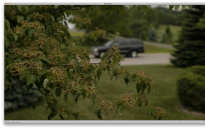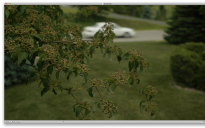
Please, support PV!
It allows to keep PV going, with more focus towards AI, but keeping be one of the few truly independent places.
It allows to keep PV going, with more focus towards AI, but keeping be one of the few truly independent places.
ND filters
-
The color shift really only happens at the blackout end of the Vari - ND range anyway, so it's not that big an issue I've found. And if you need to knock out a bit more light without going into that range, add a small ND behind the Vari -ND.
I do like an ND only for faces though, Polarizers flatten things too much. -
I see some people complaining about the "color shift" that comes with using some ND filters. My question is: wouldn't re-white balancing take care of any color shift? If so, then what would be a problem with a color shift?
Also curious about how graduated NDs play with Fader / Variable NDs if anyone knows.... Great forum BTW! -
Does anyone have any experience using Graduated NDs on top of a fader ND? Any issues with that?
A few things that seems to be a major advantage of the Fader NDs over the stacking things onto, say, a Cokin P filter holder are:
(1) you can get the exposure you want just right, instead of potentially having to change your shutter or aperture because your stacking NDs is off by just a little bit;
(2) you are not staking multiple NDs which can increase the likelihood of color shifting, loss of sharpness, etc; and
(3) if you are doing documentary-type work in which you have to transition from bright areas to dark areas while continuing to roll, fader NDs are much more elegant for doing so.
I really like using a Graduated ND on my Cokin holder, hence I'm curious about Graduated NDs on a Fader.
-
My Marumi test has been hampered by unstable outdoor lighting (thunderstorms) each evening. For the purposes of frame grabs from video on a tripod, it is probably best to keep the aperture constant between ND and non-ND and vary shutter speed? I could also take stills for higher resolution testing. I'm open to suggestions for the best test.
I used a full $5 bill as my initial test subject (borrowing from a poster's $1 tests on DVX) and when I tried to make a quick comparison composite on what I had, Photoshop gave me a warning with a link: http://www.rulesforuse.org/pub/index.php?lang=en. Pretty sure the helicopters are coming for me...
-
It's not terribly easy to adjust filters behind the lens. You have to remove the lens from the adapter and thread the filter onto the ring mounted inside. Sometimes you get a fingerprint on the filter and have to clean it off before using. It's not an ideal setup. I only bother with this on lenses that can't mount the filter up front because of vignetting or missing filter threads--or for diffusion filters/nets/stockings that look distinctly different behind the lens than in front of it.
-
I currently have a Cokin P filter holder, but the filters themselves are terrible. Over on DVXuser, the HiTech NDs seem to be much better for a bit more. But I haven't tried them myself.
@Vitaliy have you used Marumi NDs with the cokin P holder? Seems like they only sell circular style screw on filters...
Thoughts? -
Well in my experience if you use good quality water-white filters with multi-coating then you don't get image degradation by stacking multiples. Also, using 77mm filters on 52mm-, 55mm-diameter etc. lenses does not pose problems with vignetting. I'm careful on wider lenses, but typically won't stack as many filters in front of the glass. I have also modified some of my lens adapters to accept up to two filters behind the lens. For this I use cheaper 49mm ND filters. (This is a good way to use filters on wide lenses that do not have threading in front.) If you stack too much glass, you do have to start thinking about slightly changing your backfocus and infinity focus, but that's rarely a problem for me.
Hey, this is just what I do. I get pretty good results for the type of shooting I do. Your needs and results may vary. -
Summary of options:
Sorry if this is basic.
Please advise of any mistakes.
1. Coated or Uncoated NDs and Polarizers?
a. Let's not open that can of worms, eh? ... or shall we?
2. Stacking
If we are stacking filters, we'd want to go with the largest filter
we can afford for our choice of lens size
a. to eliminate the need to buy multiple sizes of filters, 'one size fits all' with correct step rings
i.e. use your 77mm filter on a 52mm front threaded lens
b. to eliminate the possibility of vignetting by stacking multiple filters
(unless, of course, you're using your 77mm filters on a 77mm lens, but that means you
purchased those oh-so-inexpensive 82mm filters, right?)
3. Stacking ND filters
a. add number of stops together when stacked
b. image degradation by stacking multiples?
c. Or buy an ND16 instead?
wiki-ped:
stops
ND2 1
ND4 2
ND8 3
ND16 4
ND32 5
ND64 6
ND128 7
ND256 8
ND512 9
ND1024 10
ND2048 11
ND4096 12
ND8192 13
So you'd need to stack an ND2,ND8,and ND16 to match most Dedicated Vari-ND's
at around ND256 (8 Stops)
Is this too many to stack? Seems so.
Anyone have an ND8192 ? :-)
4. Stacking Polarizers (4 to 15 f-stops)
some info: problems of mismatched, cheap polarizers?
http://www.digitalphoton.net/making-a-variable-nd-filter-with-circular-polarizers/
Polarizer Options:
a. (2 circulars, but must reverse the glass on the front circular)
b. (1 circular, 1 linear in front)
c. (2 linears, linears are ok to use on the m4/3 format)
Benefit of having a DIY Vari-ND made from two polarizers,
a. you also have a simple polarizer at your fingertips in addition to the DIY Vari-ND.
b. one fewer thing to carry
c. one less expense
5. Just buy a quality Vari-ND, deal with the color shift with a custom WB and the softness above
200mm
-
I use Tiffen HT ND filters. I like the option of being able to use a circular polarizer filter when I want to dial up or down reflections on glass, etc. Fader filters take away that option. They also cause significant softening and color shift to my eye. I've standardized my lenses on 77mm rings so I can switch filters between any. Filters are initially expensive but the will outlast my GH2 by years.
-
Do linear polarizers affect the metering or AF? One of the reasons circular polarizers became necessary was because metering systems and AF systems (phase detection) didn't work with a linear polarizer. However, the GH1 uses a contrast detection AF system and metering is different.
-
@xsa I am pretty happy with it. It does not seem to affect sharpness as far as the video concerned. It is very well built and while there is a shift in color from no-filter on a lens to Heliopan filter on the lens, there is no shift in color between different degrees of ND. Hope this helps.
-
I picked up a 72mm fader ND from Nature in Shanghai. www.china-nature.com.cn they can be found pretty cheap on ebay. There is nothing to complain about this fader for me so far. There might be a little loss in sharpness. I use it together with the 14-140 all the time. I'm very satisfied with this product (I have nothing to compare it against though) ...
-
Hi dkitsov,
I am also thinking to go for heliopan, could you please tel us more about it?for instance does it effect sharpnes, or does it create any color cast.
I saw it in the shop, it looks like very well made and very well callibrated, but i find price was bit high for me . So i would like to understand hiw happy you are with it.
Thanks -
I went with the Tiffen Water White IR ND 2.1 from 2filter.com. This filter is new for 2011 and is specially designed for CMOS sensors like the RED and GH2. I see a slight loss of warmth but I consider it quite good for 8 stops of light reduction. Take a look for yourself, the first shot (black SUV) is 1/4000 with No ND, the second shot (white car) is 1/50 with ND. Both ISO 160 f 2.8

 NoND.png1920 x 1200 - 3M
NoND.png1920 x 1200 - 3M
 ND.png1920 x 1200 - 3M
ND.png1920 x 1200 - 3M -
I also have the LCW II in 72mm (B&H was out of 77, or I would have got that. Bigger is better, then use step-up rings.)
I am no professional, but I've seen nothing wrong with the LCW II. It works really well! I put my camera on my indisystems UC rig, with a foam ring in the matte-box that fits snugly around the front element of the fader. turn the filter trays, and voila! . . . the fader turns as well. For stills I also find it invaluable on the M43 lenses. I'm mighty prejudice towards a good manual aperture ring (as opposed to leaving it off and adjusting in-camera), and the fader essentially gives me a physical ring that adjusts the amount of light hitting the sensor (and a smooth ring at that . . . no clicks!). the only way it might be better is if they also made a model with hard stops. IT would not be ideal in all situations, but it would come in handy once in a while. -
Start New Topic


Howdy, Stranger!
It looks like you're new here. If you want to get involved, click one of these buttons!
Categories
- Topics List23,911
- Blog5,718
- General and News1,330
- Hacks and Patches1,148
- ↳ Top Settings33
- ↳ Beginners254
- ↳ Archives402
- ↳ Hacks News and Development56
- Cameras2,342
- ↳ Panasonic984
- ↳ Canon118
- ↳ Sony154
- ↳ Nikon95
- ↳ Pentax and Samsung70
- ↳ Olympus and Fujifilm98
- ↳ Compacts and Camcorders295
- ↳ Smartphones for video96
- ↳ Pro Video Cameras191
- ↳ BlackMagic and other raw cameras116
- Skill1,959
- ↳ Business and distribution66
- ↳ Preparation, scripts and legal38
- ↳ Art149
- ↳ Import, Convert, Exporting291
- ↳ Editors190
- ↳ Effects and stunts115
- ↳ Color grading197
- ↳ Sound and Music280
- ↳ Lighting96
- ↳ Software and storage tips266
- Gear5,407
- ↳ Filters, Adapters, Matte boxes344
- ↳ Lenses1,577
- ↳ Follow focus and gears93
- ↳ Sound496
- ↳ Lighting gear313
- ↳ Camera movement230
- ↳ Gimbals and copters302
- ↳ Rigs and related stuff271
- ↳ Power solutions83
- ↳ Monitors and viewfinders339
- ↳ Tripods and fluid heads139
- ↳ Storage286
- ↳ Computers and studio gear559
- ↳ VR and 3D248
- Showcase1,859
- Marketplace2,834
- Offtopic1,314








